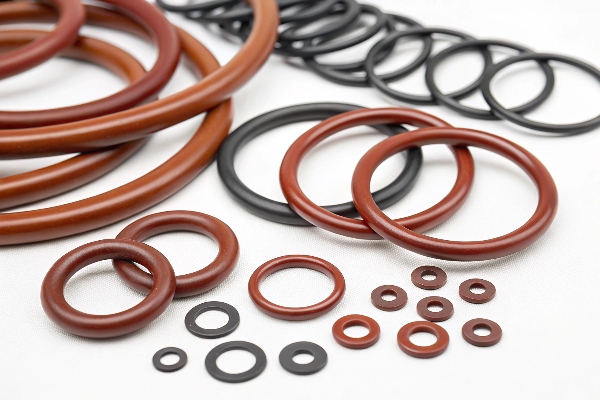Fluorosilicone is a synthetic rubber material that combines the unique properties of silicone with fluorine-based compounds. It is designed to withstand extreme temperatures, aggressive chemicals, and oils, making it ideal for specialized industrial applications. Fluorosilicone provides superior chemical resistance compared to standard silicone rubber.
Fluorosilicone is a type of rubber that offers exceptional chemical and temperature resistance, particularly in environments exposed to fuels and oils.
Let’s dive deeper into the composition and properties of fluorosilicone and explore its wide range of uses.
What is the Composition of Fluorosilicone?
Fluorosilicone is made by incorporating fluorine atoms into the polymer chain of standard silicone, which gives it enhanced chemical resistance. What makes fluorosilicone unique?1
Fluorosilicone combines silicone’s flexibility with fluorine’s resistance to fuels, oils, and chemicals, resulting in a versatile elastomer.
Fluorosilicone’s composition consists of a silicone backbone to provide flexibility and elasticity, with added fluorine atoms that significantly improve its chemical resistance. This combination makes it highly resistant to fuels, oils, and harsh chemicals while maintaining the flexibility that silicone is known for. Fluorosilicone maintains many of the desirable properties of silicone, such as high-temperature stability and excellent electrical insulation, but with the added benefit of improved chemical and oil resistance. This makes it ideal for use in environments where exposure to fuels, oils, and industrial chemicals is a concern.
Fluorosilicone Composition
| Component | Function |
|---|---|
| Silicone Backbone | Provides flexibility and durability |
| Fluorine Groups | Enhance chemical and oil resistance |
Is Fluorosilicone Oil Resistant?
Yes, fluorosilicone is highly resistant to oils and fuels. Why is fluorosilicone resistant to oil?2
Fluorosilicone's chemical structure makes it highly resistant to oils, fuels, and solvents, making it ideal for automotive and aerospace applications.
Fluorosilicone’s resistance to oil is due to the fluorine atoms incorporated into the polymer. These fluorine atoms are highly electronegative and create strong bonds with carbon, making it difficult for oils and fuels to break down or degrade the material. As a result, fluorosilicone is often used in industries like automotive, aerospace, and chemical processing, where exposure to oils, lubricants, and fuels is common. In fuel systems, gaskets, seals, and O-rings made from fluorosilicone can maintain their integrity even when exposed to aggressive chemicals.
Oil Resistance of Fluorosilicone
| Property | Fluorosilicone |
|---|---|
| Oil Resistance | Excellent |
| Common Applications | Automotive, aerospace |
Is Fluorosilicone Conductive?
Fluorosilicone is not conductive. It maintains excellent electrical insulating properties, similar to regular silicone. Is fluorosilicone used for electrical applications?3
Fluorosilicone retains its insulating properties, making it a good choice for electrical applications requiring resistance to heat and chemicals.
Fluorosilicone, like standard silicone, is a non-conductive material, making it suitable for applications requiring electrical insulation. Its excellent resistance to high temperatures and chemical exposure further enhances its suitability for electrical components. Fluorosilicone is often used in environments where electronic components are exposed to extreme conditions, such as in automotive or aerospace applications. Seals and gaskets made from fluorosilicone prevent electrical short circuits while offering resistance to the harsh chemicals often found in these industries.
Electrical Insulation Properties
| Material | Electrical Conductivity |
|---|---|
| Fluorosilicone | Non-conductive |
| Silicone | Non-conductive |
Is Fluorosilicone Flammable?
No, fluorosilicone is not highly flammable. It has a high level of flame resistance, making it suitable for use in applications exposed to high temperatures and potential fire hazards. What makes fluorosilicone fire-resistant?4
Fluorosilicone is inherently flame-resistant, making it safe for high-temperature applications in industries like aerospace and automotive.
Fluorosilicone’s flame resistance comes from its chemical structure. The presence of fluorine atoms in the polymer chain imparts a high degree of stability to the material, even under extreme temperatures. Unlike many other elastomers, fluorosilicone does not easily catch fire, and it will not support combustion under typical exposure conditions. This property makes fluorosilicone an ideal material for sealing and gasketing in industries like aerospace, where components must operate in high-temperature environments without the risk of ignition or failure.
Flame Resistance of Fluorosilicone
| Property | Fluorosilicone |
|---|---|
| Flame Resistance | Excellent |
| Ideal Applications | Aerospace, automotive |
What is Fluorosilicone Used For?
Fluorosilicone is used in applications where high resistance to oils, fuels, chemicals, and extreme temperatures is needed. Where is fluorosilicone commonly used?5
Fluorosilicone is commonly used in aerospace, automotive, and chemical processing industries due to its resistance to extreme conditions.
Fluorosilicone is widely used in aerospace, automotive, and industrial applications due to its outstanding resistance to harsh chemicals, oils, and high temperatures1. In the aerospace industry, fluorosilicone is used for seals and gaskets in fuel systems, where exposure to jet fuels and lubricants is common. In automotive applications, it is used for fuel system components like O-rings and gaskets. Fluorosilicone is also used in chemical processing plants for sealing systems exposed to aggressive chemicals and high temperatures, where materials like silicone and rubber would degrade quickly.
Applications of Fluorosilicone
| Industry | Application | Properties Leveraged |
|---|---|---|
| Aerospace | Fuel systems, fuel line seals, gaskets, high-performance components | Resistance to jet fuels & hydraulic fluids, low outgassing, static sealing, cushioning |
| Automotive | Fuel emission control systems, turbocharger hoses, spark plug boots, fuel system components | Durability in contact with gasoline and oil |
| Chemical Processing | Pumps, pipe joints, equipment containers | Resistance to corrosive chemicals and fluids (inorganic acids and organics) |
| Oil and Gas | Fuel systems at elevated temperatures, critical hydrocarbon-resilient applications | Resilience to hydrocarbons, high-temperature performance |
| Construction | Sealing rubber ring for cement single-storage pumps | Sealing properties |
| Other Industries | Pharmaceutical processing equipment, military systems, specialized parts, electrical coatings | Chemical resistance, temperature resistance |
Conclusion
Fluorosilicone rubber offers a unique combination of chemical resistance2, flame resistance, and flexibility, making it a preferred material for demanding industrial applications. Its versatility makes it ideal for use in aerospace, automotive, and chemical processing industries where exposure to extreme conditions is common. Fluorosilicone’s resistance to oils, fuels, chemicals, and high temperature
Footnotes
-
Fluorosilicone's composition, which combines silicone with fluorine, gives it enhanced resistance to oils, chemicals, and extreme temperatures, making it suitable for specialized applications like aerospace and automotive. ↩ ↩
-
The incorporation of fluorine atoms in fluorosilicone creates a highly oil-resistant material, ideal for use in fuel systems and automotive components exposed to oils and fuels. ↩ ↩
-
Fluorosilicone retains the non-conductive properties of silicone, making it suitable for electrical insulation applications in environments exposed to high temperatures and chemicals. ↩
-
Fluorosilicone's flame resistance is a key feature, thanks to its chemical structure, which prevents it from supporting combustion in high-temperature environments. ↩
-
Fluorosilicone's unique combination of chemical, oil, and flame resistance makes it perfect for use in demanding industries like aerospace, automotive, and chemical processing. ↩









